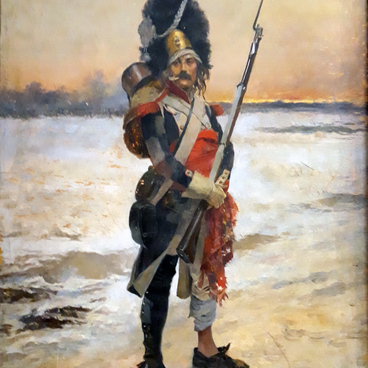The portrait of Earl Pavel Stroganov, lieutenant general, was created in XIX century. This is a copy from the work of French painter Jean Laurent Mosnier dated 1808, which is housed in the State Russian Museum in St.Petersburg.
The Tambov portrait bears no author’s signature, but experts believe the portrait could have been painted by Vassiliy Khudoyarov, an artist from a family of bondsmen in 1860-s, at the earliest. His authorship is stated on the companion portrait featuring Sofia Stroganova, Pavel Stroganov’s wife. Having been granted freedom in 1856, Khudoyarov completed a course in the Academy of Arts and painted a number of made-to-order copies, including the ones for the Royal family of the Emperor of Russia. The copies from Mosnier’s paintings were ordered from Khudoyarov by Pavel Stroganov for his family estate Znamenka in Tambov province. Today the portrait of Sofia is kept in the collection of the regional picture gallery in Tambov.
The painting features the Earl Pavel Stroganov in the third stage of his career path — the military. The stages of his service as a diplomat and the Royal Court Counsellor of the Emperor Alexander I and a diplomat were now long gone.
The Earl is wearing a double-breasted general’s dress-coat made from dark-green cloth with a red collar garnished with gold embroidery in the shape of oak leaves. There are gold general’s epaulettes on his shoulders. Such a coat was called a standard general’s coat. It was introduced for wear both in the time of peace and warfare in 1808. Stroganov’s coat is decorated with two awards: the III class Cross of St. George and the Order of Ioannes of Jerusalem, or the Maltese Cross. Emperor Pavel I conferred the latter on him (during his reign it was the highest award for the excellence in the military or civil service).The Cross of St. George was received by Stroganov for the battle with the French under command of the Field Marshal Ney in May of 1807. The awards became the evidence to the fact that the portrait was painted by Mosnier in 1808— in 1809 the Earl was awarded with the Ist degree Order of St. Anna and the IInd degree Order of St. Vladimir, but they are absent in the painting.
The Tambov portrait bears no author’s signature, but experts believe the portrait could have been painted by Vassiliy Khudoyarov, an artist from a family of bondsmen in 1860-s, at the earliest. His authorship is stated on the companion portrait featuring Sofia Stroganova, Pavel Stroganov’s wife. Having been granted freedom in 1856, Khudoyarov completed a course in the Academy of Arts and painted a number of made-to-order copies, including the ones for the Royal family of the Emperor of Russia. The copies from Mosnier’s paintings were ordered from Khudoyarov by Pavel Stroganov for his family estate Znamenka in Tambov province. Today the portrait of Sofia is kept in the collection of the regional picture gallery in Tambov.
The painting features the Earl Pavel Stroganov in the third stage of his career path — the military. The stages of his service as a diplomat and the Royal Court Counsellor of the Emperor Alexander I and a diplomat were now long gone.
The Earl is wearing a double-breasted general’s dress-coat made from dark-green cloth with a red collar garnished with gold embroidery in the shape of oak leaves. There are gold general’s epaulettes on his shoulders. Such a coat was called a standard general’s coat. It was introduced for wear both in the time of peace and warfare in 1808. Stroganov’s coat is decorated with two awards: the III class Cross of St. George and the Order of Ioannes of Jerusalem, or the Maltese Cross. Emperor Pavel I conferred the latter on him (during his reign it was the highest award for the excellence in the military or civil service).The Cross of St. George was received by Stroganov for the battle with the French under command of the Field Marshal Ney in May of 1807. The awards became the evidence to the fact that the portrait was painted by Mosnier in 1808— in 1809 the Earl was awarded with the Ist degree Order of St. Anna and the IInd degree Order of St. Vladimir, but they are absent in the painting.
Stroganov’s hairstyle is characteristic of Russian officers’ in the beginning of XIX century. By 1806, the army rules had undergone changes, and the shortened braid was cut in the tar to the same brush manner. General Stroganov’s hair in the portrait is slightly bepowdered— it was allowed to the officers of the highest rank up to 1809.



